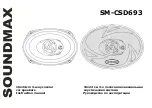
GOLDBERG AND MÄKIVIRTA
OPTIMISED EQUALISATION COMPARISON
AES 116TH CONVENTION, BERLIN, GERMANY, 2004 MAY 8-11
5
LF subband as indicated by the smaller errors bars.
For all loudspeakers pooled together (Figure 1), the
equalisation reduces the variance in the median level
for the LF subband. In Figure 4, Appendix B, the re-
sults are pooled for all products and for each product
type. The change in quartile difference and RMS de-
viation for the broadband and the subbands is illus-
trated. Across all models, the broadband flatness is
improved by 1.4 dB and the mean reduction in the LF
subband RMS deviation is 2.0 dB.
The average time taken for room response control
optimisation is 1.83 s ± 0.68 s. The best case is 1.12 s
and the worst case is 2.97 s.
Median Levels in Subbands - Small Two-way Systems
-6
-4
-2
0
2
4
6
8
LF
MF
HF
LF
MF
HF
LF
MF
HF
Original
Room Reponse Controls
Graphic Equaliser
Median Levels in Subbands - Three-way Systems
-6
-4
-2
0
2
4
6
8
LF
MF
HF
LF
MF
HF
LF
MF
HF
Original
Room Reponse Controls
Graphic Equaliser
Median Levels in Subbands - Two-way Systems
-6
-4
-2
0
2
4
6
8
LF
MF
HF
LF
MF
HF
LF
MF
HF
Original
Room Reponse Controls
Graphic Equaliser
Median Levels in Subbands - All Systems
-6
-4
-2
0
2
4
6
8
LF
MF
HF
LF
MF
HF
LF
MF
HF
Original
Room Reponse Controls
Graphic Equaliser
Median Levels in Subbands - Large Systems
-6
-4
-2
0
2
4
6
8
LF
MF
HF
LF
MF
HF
LF
MF
HF
Original
Room Reponse Controls
Graphic Equaliser
Figure 1. Mean and standard deviation of subband median levels before and after room response control and graphic
equalisation.
5.2. Graphic Equalisation
Appendix D (Figures 9-13) depicts the use of the
equaliser controls for each loudspeaker group. The
upper graph (a) shows how the graphic equaliser is
used including the use of 0 dB settings. The lower
graph (b) shows how it is used excluding the use of 0
dB settings and therefore demonstrates how much EQ
is required when it is used. Values for the 16 kHz and
20 kHz bands can be ignored as they are outside the
optimisation frequency range in all cases.
The small two-way models (Figure 9) show a general
trend of bass reduction, –3 to –5 dB, but with some
additional large midrange adjustments and small high
frequency balancing. The standard deviations are
large, indicating that there is little consistency in the
required equalisation across loudspeakers.
The two-way models (Figure 10) show a general trend
of bass reduction, –2 to –4 dB, slightly less midrange
reduction, –1 to –2 dB, adjustment and small high fre-
quency shelving too. Equalisation is required in lower
frequency bands as these systems have a deeper bass
extension. The standard deviations are small indicat-
ing that there is more consistency in the required
equalisation across loudspeakers. In general, less
equalisation is required than for the small two-way
systems.





































